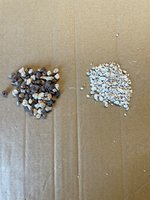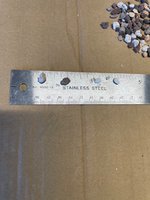Natty Bumppo
Yamadori
The nearest NAPA is about 25 miles away. There's an O'Reilly's about a mile from me. Haven't used 8822, but have used Opti-Sorb from O'Reillys. Maybe 20% sifts out through a 2mm screen. I use probably 60-65% Opti-Sorb and use perlite, pumice and pine bark fines for the rest. In 2 growing seasons so far, I've no complaints.
O'Reilly sells both Opti sorb and oil sorb. I think the opti-sorb is the D.E. one I've used. I think the other stuff is a clay product. From what I've seen elsewhere on line, Opti-Sorb has larger average particle size than 8822, but more variability in particle size.
O'Reilly sells both Opti sorb and oil sorb. I think the opti-sorb is the D.E. one I've used. I think the other stuff is a clay product. From what I've seen elsewhere on line, Opti-Sorb has larger average particle size than 8822, but more variability in particle size.



